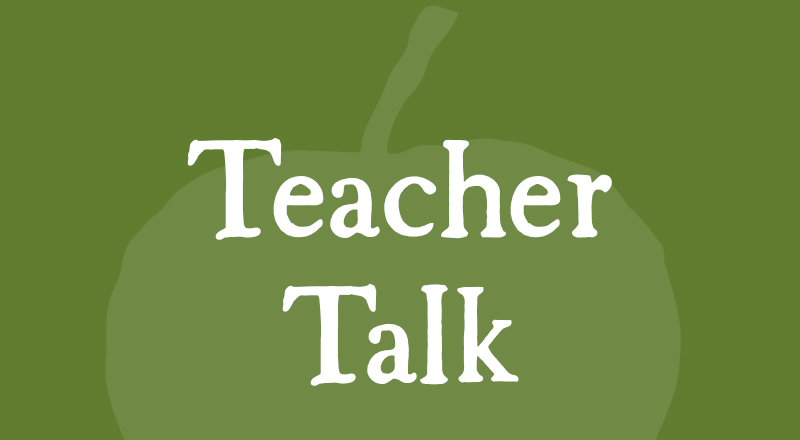Teacher Talk: Literacy and numeracy in a kitchen garden program

This edition of Teacher Talk is inspired by National Literacy and Numeracy Week, which was celebrated earlier in September across Australia.
Every day we are surrounded by opportunities to expand our skills in literacy and numeracy in a range of environments and contexts. This article investigates ways of exploring literacy and numeracy through a kitchen garden program.
This learning can occur by osmosis, depending on the situation. It can also be targeted and deliberate – whether through hands-on activities in the kitchen and garden spaces, or by making learning links between the classroom and a kitchen garden program.
As well, learning can be differentiated to suit the developmental continuum of all students taking part in a kitchen garden program from Foundation through to Year 10.
The following are learning activities you can undertake in the kitchen and the garden. These activities relate to the elements of the general capabilities in the Australian Curriculum for literacy and numeracy. The activities also support teaching literacy and numeracy across the learning areas of the curriculum.
Literacy
Grammar knowledge
Students keep diaries, journals and blogs on their personal learning experiences from the time they have spent in both the kitchen and garden. They can also cultivate expressing themselves through writing for different audiences (for example, writing for their peers, for someone new to a kitchen or a garden, or writing for adults). They can also get creative, using different text types such as rhymes or poems to reflect on, for example, the effect of the seasons on the garden.
Text knowledge
Students explore a range of texts from both fiction and non-fiction categories that focus on themes and topics relating to the kitchen garden. They learn to understand information, to analyse new information, and to respond to that information. For example, students using recipes to prepare dishes in the kitchen are learning how to use procedural texts.
Word knowledge
In the classroom, students develop word lists and glossaries of words used in the kitchen and garden. Students actively expand their vocabulary and learn about metalanguage when constructing sentences using a range of different words accurately, and experimenting with expression. Try comparing words derived from another language, including traditional Aboriginal words (such as those for plant names, for example).
Visual knowledge
In kitchen and garden activities, students deepen their understanding of visual knowledge by examining how meaning is formed by the relationship between pictures and words. Use visual displays, such as graphic organisers, for students to record ideas or fieldwork data; look at visual information on packaging, for example on seed packets or packaged ingredients, to analyse why particular imagery is used for a product for the kitchen and garden. Explore opportunities to expand on digital literacy by creating a school kitchen garden webpage or wiki, that actively combines text and still or moving images – this develops skills in information communication technologies.
Numeracy
Estimating and calculating with whole numbers
Get counting in the garden! How many types of plants, vegetables and edible flowers are in the garden? How many varieties of each? How many items of each were harvested? Estimate how much soil can be held in a wheelbarrow or how many vegetables will be gained when harvesting different crops. When cooking muffins in the kitchen, estimate and calculate appropriate length of cooking times, for different temperatures. Calculate how many muffins a recipe will make, and divide into muffin trays.
Recognising and using patterns and relationships
Students observe the natural patterns that can be found in the garden, looking for symmetry and asymmetry in plants and flowers. Consider relationships that exist in nature and the garden for plant life to thrive. Design garden beds ready to plant using patterns and the golden mean. Ask students to record what they discover.
Using fractions, decimals, percentages, ratios and rates
Dish up fractions when getting ready to share meals and dishes that have been prepared in the kitchen. Divide food to share in a group, while considering portion size so that there’s enough for everyone to taste. Count money, and practise using decimals when preparing budgets for stocking the pantry, or for working out the costs and targets of a fundraiser.
Using spatial reasoning
Plants need room to grow! When designing a new garden or vegetable bed, encourage students to consider the amount of space individual plants need to flourish, and how to accommodate these needs in the garden’s design and plan. Think also about environmental factors, such as geographical position and light.
Interpreting statistical information
The garden is an ideal place to collect data on a range of environmental factors – students can get involved in logging data to track rainfall, temperature, plant growth, hours of sunlight, wind and weather conditions, and more. Data collected over time can be presented visually using a range of graphs and analytical approaches.
Using measurement
The kitchen is ideal for practising and expanding skills in measurement. Students actively measure out ingredients when cooking in the kitchen: they use measuring cups and jugs to work out liquid measures in millilitres and litres, and they use scales to work out the weight of dry ingredients in grams and kilograms.
Happy teaching!

Steph Davies, Education Advisor
< Back to Latest News
